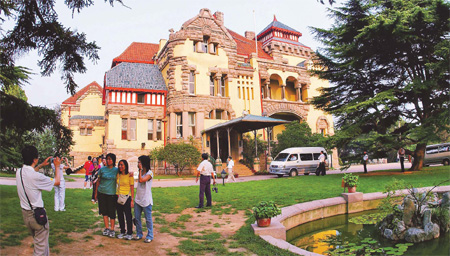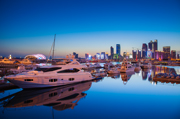Chinese city, German accent
( chinadaily.com.cn )
Updated: 2011-09-07
|
|||||||||
 |
|
Many of Qingdao's tourist attractions were built when the city was still a German concession, and Teutonic influences are clearly apparent. Provided to China Daily |
There is more than just that famous malty brew in Qingdao, in fact the former German concession has a charm that is very much all its own, as Li Yao discovers.
A German friend once stepped into a university cafe in Shanghai and confidently ordered a beer. "Tsing-tau, please," he said. The waitress courteously took the order and brought back, well, something he least expected - a pair of scissors. (In Chinese, the words for scissors and Tsingtao sound similar, especially for foreigners who have difficulty articulating the tones.)
Seeing his baffled face, I laughed out loud while correcting his order, but told him I appreciated his polite interest in speaking Mandarin and in tasting a popular Chinese brand. Perhaps there is more than just that. Many German visitors have a soft spot and a remote connection to Qingdao, where the Tsingtao Brewery created by German expatriates in 1903 continues to produce the world-renowned beer.
There is certainly truth in saying that Qingdao is a Chinese city with a German accent. The port city in the eastern part of Shandong province owes much of its charm and quaintness to its German texture, cobblestoned streets, red-tiled roofs, tree-lined avenues, and an out-of-place Bavarian appearance adorned by century-old European architecture.
From 1897 to 1914, Germany administered Qingdao as a concession and expanded its infrastructure and harbor. The occupiers built the railway station and a sewage system, piped in spring water from Laoshan Mountain and set up a brewery to quench the thirst of homesick German soldiers.
Much of the town's original planning has been kept intact, and the architectural heritage eventually evolved into the backbone of Qingdao's booming tourism, and a source of metropolitan pride.
Strolling at leisure is the best way to explore the town, watch the oceanfront sunrise, enjoy the languid beach promenades, and visit the old mansions in the German quarter.
Badaguan, meaning The Eight Great Passes, is the former German residential area. Now filled with cafs and boutiques, the spacious streets each lined with a particular type of tree, offer visitors a lush walk within sight of many European villas built during the German occupation.
Starting from the beautiful train station, people can visit many landmarks on foot, including a commanding catholic cathedral with twin spirals, St. Michael's Church. It remains an active place of worship and holds regular masses. The quiet and sunlit church is a popular site for people taking photographs for their wedding albums.
A few minutes southeast is the protestant church built in 1910 in German art-nouveau style. This elegant structure features a distinctive 39-meter clock tower, sandy yellow walls and red-tiled roof on the exterior.
To the east is Signal Hill, where flags were once raised to direct ships in the harbor. Climbers are rewarded with an idyllic view of the sparkling sea and the two churches nestled in the picturesque German quarter.




